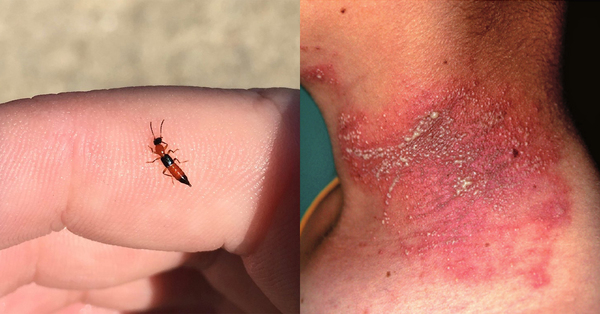Eamon Corbett/Flickr
& Enver Turan/ResearchGate
Subscribe to our Telegram channel for our latest stories and breaking news.
Facebook user Jamie Chin warned her followers about the existence of Charlie ants and encouraged people to learn what they look like to avoid them.
“The weather is really hot lately, that’s the peak of when Charlie ants come out,” she warned in a post that has since garnered over 8,500 shares.
“Everyone should remind their children that if they see these ants, absolutely DO NOT squash them with their bare hands!”
She asked people not to underestimate the damage they can do to a person’s skin, and that these ‘ants’ often lurk in places such as showers, sinks, clothes, and curtains.
These beetles go by the name ‘Charlie ant’ in Malaysia due to their similar appearance to ants when they are crawling on the ground.
However, the name is a misnomer for they are actually known worldwide as rove beetles.
Rove beetles are six-legged creatures ranging from 1cm to 3.5cm long and have distinctive orange bodies with a black head, abdomen, and tip.
Bad news: These beetles have wings and can fly. Their wings are hidden beneath the black part of their abdomens and they often look like wasps when they are in the air.
According to researchers from Universiti Sains Malaysia (USM), rove beetles can be found in India, Pakistan, Sri Lanka, Iran, Iraq, and throughout Southeast Asia.
This is because these beetles thrive in moist habitats such as crop fields, riverbanks, drains, pools, and lakes.
They are commonly found in the northern states of Penang, Kedah, and Perlis in Malaysia, especially around paddy fields.
USM researchers found that rove beetles are actually beneficial in agriculture because they eat other insects and pests in paddy fields.
However, with hot weather and human activities that disrupt their natural habitat such as harvesting and ploughing of rice fields, rove beetles reproduce and leave in massive infestations to nearby residential areas.
These flying beetles are attracted to fluorescent lights so they will often invade brightly-lit buildings.
The toxin found in the fluid of their bodies burns the skin and causes dermatitis linearis – a painful rash that is red and itchy and may develop into blisters if not taken care of properly.
The lesions appear 24 to 48 hours after contact with the toxin and can take several weeks to heal.
The rashes normally appear elongated because a person’s first instinct when killing an insect is to squash and smear it across the skin.
The painful lesions are also often described as mirror images by doctors, a tell-tale sign that a beetle was squashed between two surfaces of skin such as between the elbows.
Many times, victims also accidentally touch their eyes with the toxic fluid still on their hands and develop conjunctivitis.
As also mentioned by this pest control guide:
– Switch off or minimise lighting indoors and vigilantly close all doors and windows at night when there’s an infestation.
– Use mosquito netting, aerosol insect spray, or glue traps to catch and kill the bugs.
– If a rove beetle lands on your body, do not squash it. Blow it away then kill it with a spray.
– If the rove beetle is crushed on your skin, wash the affected area immediately with soap and water. Do not touch your eyes!
– Seek medical attention immediately if you suffer a severe skin reaction after an encounter with the insect.



